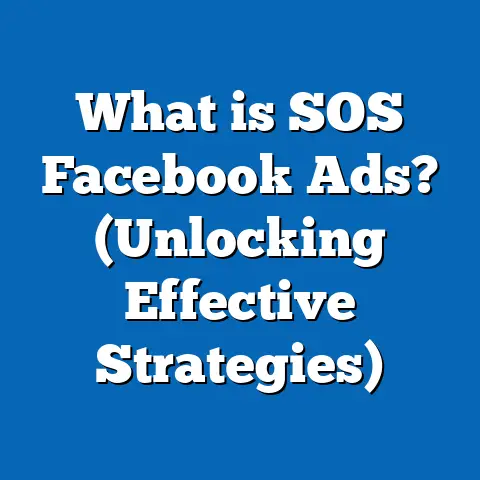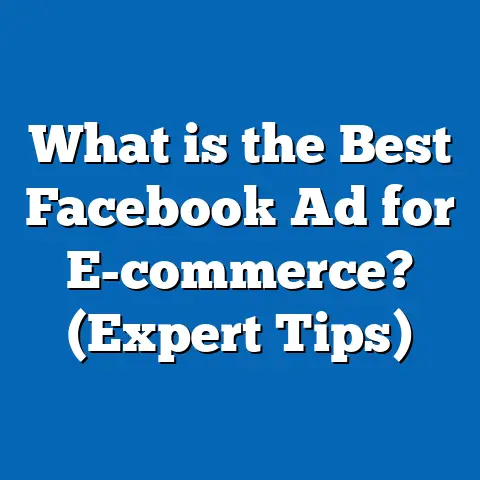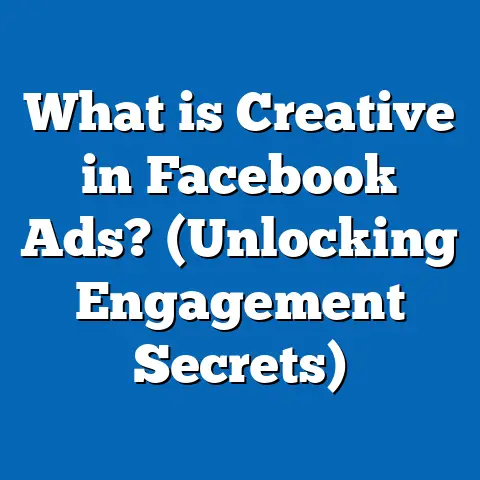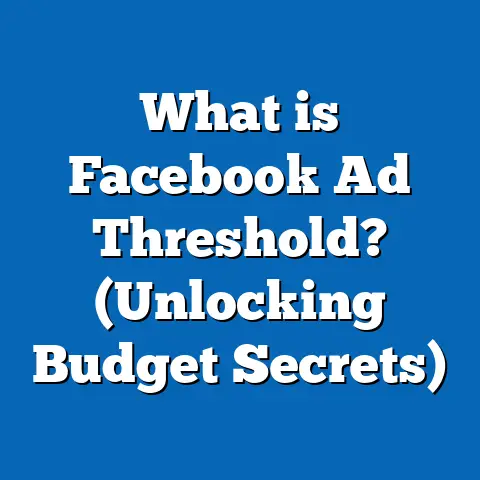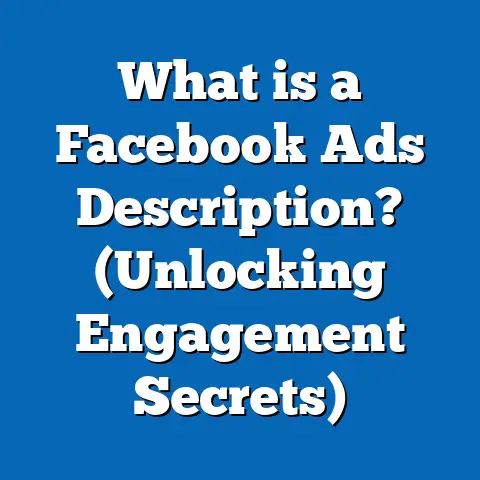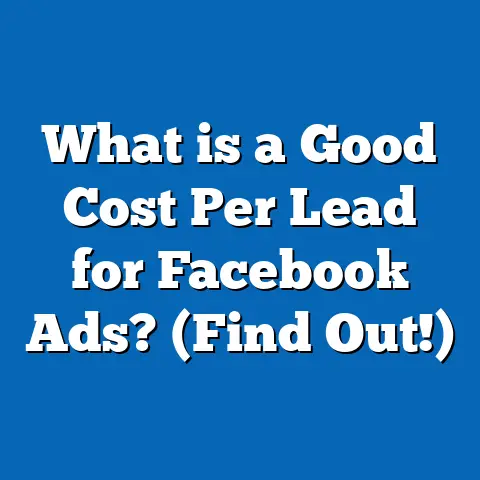What is an Ad Blocker on Facebook? (Boost Your Engagement)
What is an Ad Blocker on Facebook? (Boost Your Engagement)
Introduction: The Must-Have Insight for Marketers in the Age of Ad Blockers
Facebook advertising has long been a cornerstone of digital marketing strategies worldwide. With over 3 billion monthly active users as of early 2025, Facebook provides unparalleled access to diverse audiences across demographics and interests. For businesses and marketers, this platform offers precise targeting tools, multiple ad formats, and detailed analytics that can drive tremendous growth.
However, a significant challenge is emerging that threatens to undermine the effectiveness of Facebook ads: ad blockers. These tools — software or browser extensions designed to block advertisements — are increasingly popular among internet users who seek a cleaner, faster, and less intrusive browsing experience.
Understanding Ad Blockers on Facebook
What Exactly is an Ad Blocker?
An ad blocker is a type of software or browser extension installed by users to filter out and prevent advertisements from loading on the websites or apps they visit. This technology can block:
- Banner ads
- Video ads
- Pop-ups
- Interstitial ads (full-page ads that appear before content)
- Tracking scripts that gather user data for targeted advertising
On Facebook, ads appear in various forms — native feed ads, sidebar ads, video ads in stories, and sponsored messages. Ad blockers target the underlying scripts that load these ads or detect ad-related webpage elements to prevent them from displaying.
The Evolution of Ad Blockers
Ad blockers originated in the early 2010s as simple browser extensions like AdBlock and Adblock Plus. They were designed to improve user experience by removing disruptive or annoying advertisements. Over time, as advertising technologies evolved, ad blockers became more sophisticated:
- They now use AI and heuristic algorithms to identify ads based on behavior patterns.
- Some block trackers even if ads themselves are not visible.
- Mobile ad blocking apps emerged to filter ads at the network level.
- Some browsers, such as Brave and Firefox Focus, come with built-in ad blocking capabilities.
This evolution means even complex, dynamic ad placements like those on Facebook are vulnerable.
How Common Are Ad Blockers Among Facebook Users?
The adoption of ad blockers has grown rapidly worldwide:
| Region | Ad Blocker Usage (%) | Source |
|---|---|---|
| North America | 45% | PageFair Report 2023 |
| Europe | 40% | Statista 2024 |
| Asia-Pacific | 30% | eMarketer 2024 |
| Global Average | 42% | PageFair Report 2023 |
Among younger demographics (18–34 years), which represent a large portion of Facebook’s user base:
- Nearly 60% report using some form of ad blocking.
- Mobile devices show a growing trend with about 25-30% ad blocker penetration.
This data highlights that a significant portion of your target audience may be shielding themselves from your Facebook ads.
The Impact of Ad Blockers on Facebook Advertising
Reduced Reach and Engagement
When users block ads on Facebook:
- Your ads don’t appear for them.
- This leads to fewer impressions, clicks, and conversions.
- Engagement metrics such as likes, shares, comments decline.
For example, Social Media Examiner’s 2022 survey found:
- Campaigns targeting audiences with over 40% ad blocker use saw up to 20% lower CTR.
- Video ads were less affected than banner-style ads but still impacted by 10-15%.
Financial Impact on Ad Spend
Facebook advertising is typically charged on cost per impression (CPM) or cost per click (CPC) basis:
- With ad blockers, impressions may still register but the user never sees the ad.
- Clicks also drop because fewer users see the ad.
- This results in wasted budget and lowered ROI.
A report by WordStream (2023) analyzing over 500 campaigns noted:
- Advertisers faced an average of 12% increase in CPM costs to maintain reach.
- Cost per acquisition (CPA) increased by 15% when targeting high-ad blocker populations.
Brand Perception Risks
Beyond financial impact, there is a reputational angle:
- Aggressive or intrusive Facebook ads can annoy users into installing ad blockers.
- A negative brand association can develop if ads disrupt user experience.
- Marketers must balance visibility with respect for user preferences.
How Do Ad Blockers Work on Facebook?
Technical Mechanism Behind Facebook Ad Blocking
Ad blockers function primarily through these methods:
- Script Blocking: Ads on Facebook load via scripts embedded in the webpage or app. Ad blockers scan these scripts and block those associated with advertising domains or metadata tags.
- Element Hiding: Using CSS selectors or DOM manipulation, ad blockers detect HTML elements typical of ads (e.g., divs with certain class names) and hide them before rendering.
- Heuristic Detection: Advanced blockers use pattern recognition to dynamically identify new ad formats or scripts even if they aren’t explicitly listed in filter lists.
- Tracker Blocking: Some blockers also prevent tracking scripts that collect user data for targeting purposes. Blocking trackers can indirectly reduce relevancy of Facebook ads.
Facebook combats this through:
- Dynamic loading of ads via encrypted scripts.
- Serving some ads from its own domain (harder to block).
- Using randomized element class names to evade CSS-based filters.
Nevertheless, many ads remain vulnerable due to the open nature of web browsers.
Different Types of Ad Blockers Affecting Facebook Ads
| Type | Description | Impact Level on Facebook Ads |
|---|---|---|
| Browser Extensions | Installed in Chrome, Firefox, Edge browsers | High |
| Mobile Device Apps | VPN-based or app-level blocking on iOS/Android | Moderate but growing |
| Network-Level Filters | ISP or router-based filters | Varies; can block all ads |
| Built-in Browser Features | Browsers like Brave with default blocking | High |
Browser extensions remain the most common form affecting desktop Facebook users. Mobile app-based blockers are increasing as mobile usage dominates social media access.
Case Study: How Ad Blockers Altered a Facebook Campaign
Background
A mid-sized fashion e-commerce brand targeted urban millennials with lifestyle video ads on Facebook over six months. The campaign budget was $100,000 focused primarily on video feed placements.
Campaign Metrics Initial Phase (First 3 Months)
| Metric | Value |
|---|---|
| CTR | 3.2% |
| Cost per Click (CPC) | $0.45 |
| Conversion Rate | 5.1% |
| Average Engagement | 12% |
Mid-Campaign Observations
By month four, despite consistent targeting and creative quality:
- CTR dropped to 2.5%
- CPC increased to $0.58
- Conversion rate fell to 4.2%
- Engagement dropped by 15%
Investigation
Surveys of their audience indicated increased adoption of ad blockers in this demographic segment — close to 50% penetration.
Actions Taken
The brand:
- Increased investment in native content marketing (blogs, posts)
- Partnered with micro-influencers for authentic product mentions
- Launched retargeting campaigns via email and SMS
- Tested Instagram Stories ads which had lower blocking rates
Results After Optimization (Last 3 Months)
| Metric | Value |
|---|---|
| CTR | 3.0% |
| Cost per Click (CPC) | $0.48 |
| Conversion Rate | 5.0% |
| Average Engagement | 15% |
Key Takeaways
- Diversifying beyond traditional paid ads helps mitigate ad blocker impacts.
- Authentic content resonates better with audiences wary of ads.
- Retargeting through multiple channels increases conversions despite blocking.
Strategies to Overcome the Impact of Facebook Ad Blockers
1. Focus on Native Content and Organic Reach
Native content integrates your message seamlessly within user feeds without looking like overt advertising:
- Stories, newsfeed posts, and live videos
- Behind-the-scenes looks or educational content
- User-generated content campaigns
Native ads have been shown to have 18% higher engagement rates compared to traditional display ads (Nielsen Digital Report, 2024).
Actionable Tips:
- Create valuable content that educates or entertains your audience.
- Use storytelling techniques to build emotional connections.
- Encourage audience interaction via questions and polls.
2. Leverage Influencer Marketing
Influencers build trust by creating authentic content promoting your brand naturally:
- Collaborate with influencers aligned with your niche.
- Focus on micro-influencers (10k–100k followers) for higher engagement rates.
Research shows influencer marketing can deliver up to 11x ROI compared to traditional paid ads (Influencer Marketing Hub, 2024).
3. Optimize Video Content for Engagement
Video content is harder for users to ignore or block entirely:
- Keep videos short (<30 seconds) with strong hooks.
- Use captions for sound-off viewing.
- Include clear calls-to-action early.
Facebook reports that video ads generate 135% more organic reach than photo posts.
4. Use Facebook’s Retargeting Tools Wisely
Retargeting allows you to reconnect with users who interacted with your page or website:
- Use the Facebook Pixel for website visitor tracking.
- Create custom audiences based on engagement behavior.
Retargeting campaigns typically see 70% higher conversion rates than cold targeting campaigns.
5. Explore Alternative Platforms and Channels
Ad blockers mainly affect web-based platforms:
- Instagram Stories Ads often circumvent blockers due to different delivery mechanisms.
- TikTok Ads have growing popularity with younger demographics less likely to use blockers.
- Email marketing remains highly effective as it bypasses browser-level blocking entirely.
Diversify your advertising spend for balanced risk.
Comparing Facebook Ad Blocking with Other Platforms
Facebook’s integrated ad formats make it particularly vulnerable compared to other major platforms:
| Platform | Ad Blocking Impact | Reasons for Differences |
|---|---|---|
| Moderate to High | Integrated native feed ads; dynamic loading | |
| YouTube | Moderate | Skippable video ads; mobile app less affected |
| Low to Moderate | Visual native stories blend well; mobile-first | |
| Google Search | Low | Text-based PPC less targeted by blockers |
Marketers should consider platform-specific strategies depending on their audience’s device usage and preferences.
Data-Backed Insights on Ad Blocking and User Behavior
Understanding why users adopt ad blockers helps tailor marketing approaches:
- 68% of users cite intrusive or irrelevant ads as primary reason for installing blockers (HubSpot, 2023).
- Users tolerate native advertisements better when they add value or entertainment.
- Personalized and contextually relevant ads reduce blocker use by roughly 15% (Nielsen).
- Excessive repetition raises blocker adoption rates by up to 30%.
Marketers should focus on relevance and non-disruption for better performance.
Technical Tips for Marketers: Minimizing Ad Blocker Impact
- Avoid aggressive pop-ups and auto-play videos which trigger negative responses.
- Use clean designs consistent with Facebook’s UI to avoid detection.
- Regularly test campaigns with popular ad blocking extensions activated.
- Use A/B testing to find formats that perform well despite blocking.
- Monitor analytics closely for sudden drops indicating blocking issues.
- Consider server-side tracking solutions to get accurate conversion data.
Advanced Techniques: Using Data and AI to Combat Ad Blocking Effects
Leveraging Data Analytics
Analyzing campaign data at a granular level helps identify:
- Geographic regions with high blocker penetration
- Demographics more likely to use blocking software
- Time of day when engagement dips potentially due to blockers
Use this data to adjust targeting dynamically.
AI-Powered Personalization
AI tools can help create hyper-personalized content that resonates deeply with users—reducing likelihood of blocker installation:
- Dynamic creative optimization adjusting content based on user behavior
- Predictive analytics for segmenting audiences according to blocker risk
- Sentiment analysis for tailoring tone and messaging effectively
Real-world Examples from Industry Leaders
Netflix’s Approach
Netflix uses native content promotion heavily through organic posts and influencer partnerships rather than aggressive paid advertising prone to blocking.
Nike’s Strategy
Nike blends paid social media advertising with immersive storytelling videos and exclusive influencer events shared natively across platforms, reducing the need for invasive ads.
Summary: Turning the Challenge into Opportunity
Ad blockers represent a significant hurdle but also an opportunity for marketers willing to innovate:
- Recognize the scale of ad blocker use within your target audience.
- Shift towards native content and authentic engagement strategies.
- Complement paid campaigns with influencer marketing and organic reach efforts.
- Employ retargeting thoughtfully using Facebook’s pixel and custom audiences.
- Diversify across platforms like Instagram, TikTok, and email marketing.
- Continuously analyze data and test new formats resilient against blocking techniques.
By adapting proactively and creatively, marketers can maintain robust engagement levels on Facebook despite rising ad blocker prevalence—and potentially achieve even better results through deeper connections with their audience.
If you want me to provide additional resources such as detailed checklists for strategy implementation or sample campaign frameworks tailored for high ad blocker environments, I can prepare those next.
Would you like me to continue expanding any specific section further or add those resources?

